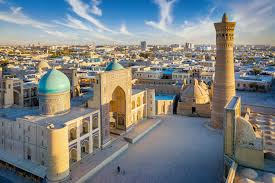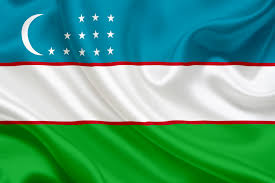Here we are at another Monday, I wasn’t sure I would do a
post today due to feeling tired and worn out and not having a lot of motivation
but here I am writing about the country of Uzbekistan, not a country I have heard
of but I do like doing posts about places and other stuff I know little or nothing
about. This country has a population of around
36 million.
Uzbekistan is a Central Asian nation and former Soviet
republic. It's known for its mosques, mausoleums and other sites linked to the
Silk Road, the ancient trade route between China and the Mediterranean.
Samarkand, a major city on the route, contains a landmark of Islamic
architecture: the Registan, a plaza bordered by 3 ornate, mosaic-covered
religious schools dating to the 15th and 17th centuries
The capital city is Tashkent, it’s known for its many museums and its mix of modern and Soviet-era architecture. The Amir Timur Museum houses manuscripts, weapons and other relics from the Timurid dynasty. Nearby, the huge State Museum of History of Uzbekistan has centuries-old Buddhist artifacts. The city’s skyline is distinguished by Tashkent Tower, which offers city views from its observation deck.
The official currency is the Sum, the country replaced the
ruble with the sum at par in on 16 July 1994. No subdivisions of this sum were
initially issued and only banknotes were produced, in denominations of 1, 3, 5,
10, 25, 50, 100, 200, 500, 1,000, 5,000, and 10,000 sum. Further series,
however, have introduced coins and a subunit, the tiyin. Because it was meant
to be a transitional currency, the design was rather simplistic.
The flag of Uzbekistan is a horizontal triband with
three equal bands of blue, white, and green, separated by two thin red
stripes. In the upper left canton (hoist side), there's a white crescent
moon and twelve white stars. The blue band represents the sky and water
and is also associated with the Turkic peoples. The white represents peace
and purity. The green symbolizes nature and new life. The red stripes
are a symbol of the power of life. The crescent moon is a traditional
Uzbek symbol, and the twelve stars represent the twelve months of the Islamic
calendar and the constellations.
Islam is the predominant religion, with the vast majority of
the population identifying as Muslim. While Islam is dominant, there are
also other officially recognized faiths, and the country has a diverse
religious landscape.
Other faiths are also present, including Russian Orthodox
Christianity, Judaism, Buddhism, there are also significant populations of
Baha'is, Zoroastrians, and Roman Catholics.
Uzbekistan's government acknowledges religious freedom, but
it also maintains a system of state control over religious organizations,
including registration requirements and oversight of religious literature. The
Muslim Board of Uzbekistan (MBU) plays a significant role in managing Islamic
affairs, and it works within a framework established by the government.
Uzbek is a Karluk Turkic language spoken by Uzbeks. It is
the official and national language of Uzbekistan and formally succeeded
Chagatai, an earlier Karluk language endonymically called Türki or Türkçe, as
the literary language of Uzbekistan in the 1920s. However, many other native languages are
spoken in the country. These include several other Turkic languages, Persian
and Russian.











The architecture of these countries just amazes me. So elaborate.
ReplyDeleteYeah I thought that as well
DeleteSuch an interesting country. Thanks for the info, Jo-Anne!
ReplyDeleteIt's what I do
DeleteMy goodness. It the name of a Country that I have seen written rarely, mentioned more rarely but it is one I have heard of and knew nothing about. I admit that Islamic Countries are not on my book lists.
ReplyDeleteI also knew nothing about the country but the name rang a bell
DeleteFascinating.. always love learning more about various countries.
ReplyDeleteI like writing about different counties
DeleteYou have been showing me that there are MANY new countries that were not on the map I studied in grade school in the 50s!
ReplyDeleteThere are many countries I didn't know existed as well
DeleteThis is so cool! I love that you just dive into learning about a new place, even when you're feeling tired. Uzbekistan sounds absolutely fascinating, especially with its Silk Road history and those incredible mosaic buildings in Samarkand. Thanks for sharing all these interesting facts about the culture and even the flag!
ReplyDeletehttps://www.melodyjacob.com/
Thanks for dropping by and having read I like that people find my posts interesting
DeleteI admit to knowing very little about the central Asian republics.
ReplyDeleteYou are not alone in that regard
Delete